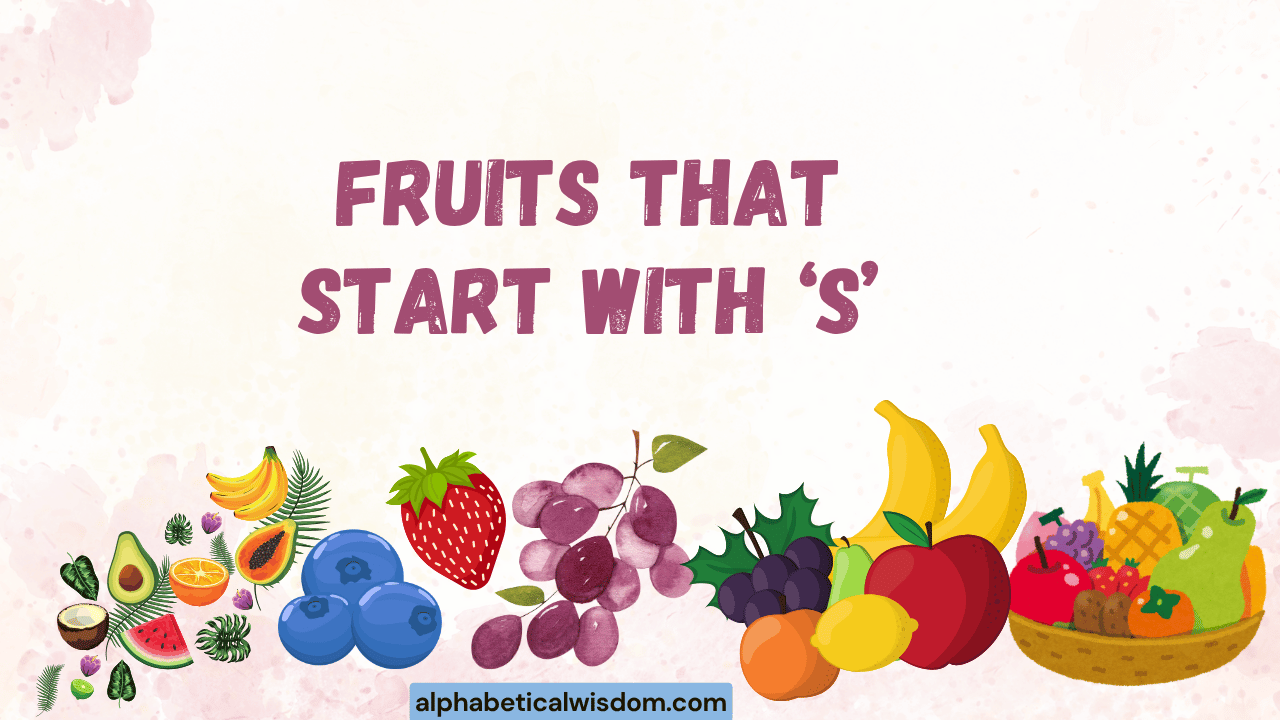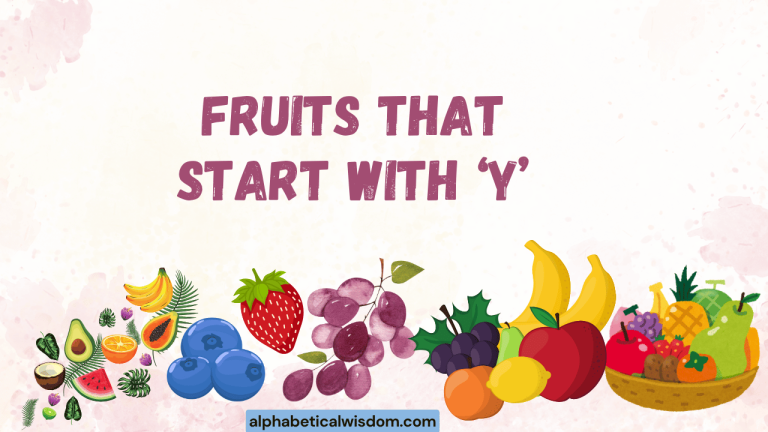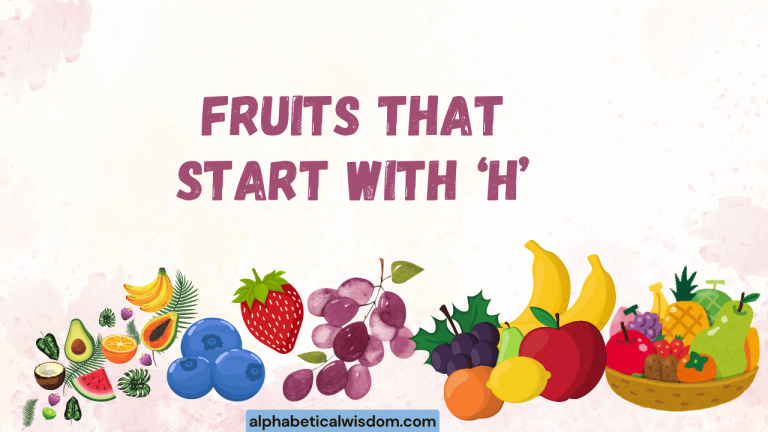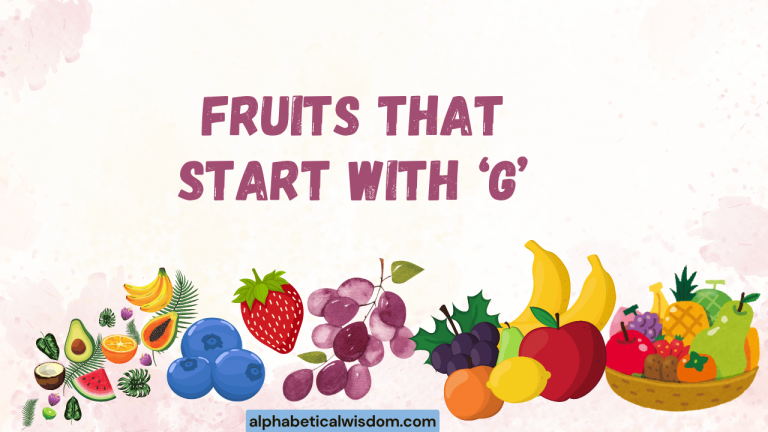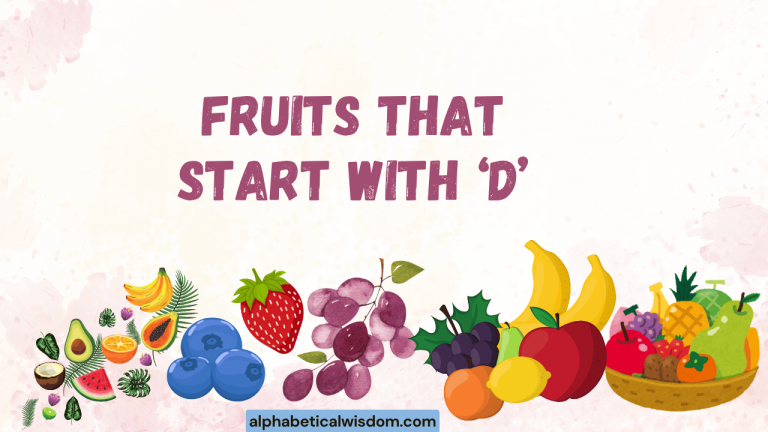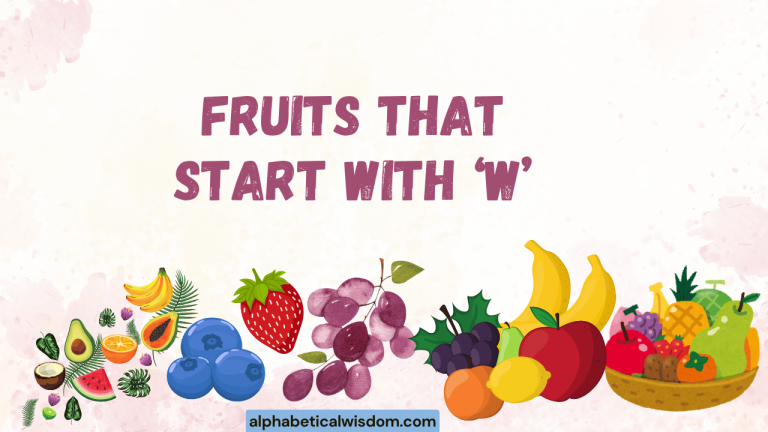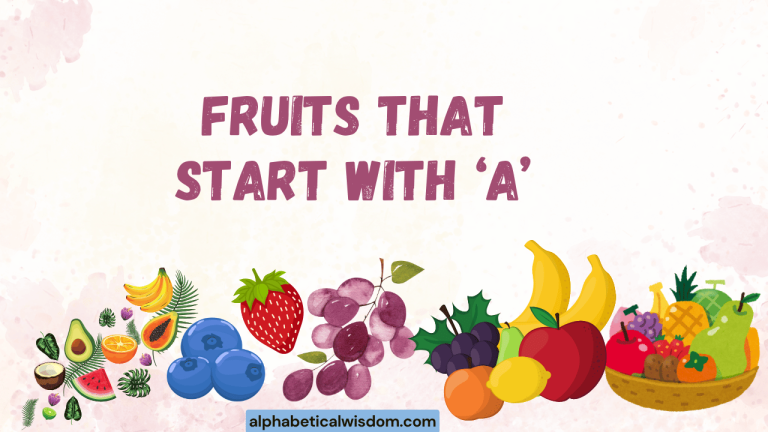Fruits That Start With S: Names, Grammar, and Usage
Understanding nouns, especially those referring to specific objects like fruits, is a fundamental aspect of English grammar. This article focuses on fruits whose names begin with the letter “S,” exploring their grammatical properties, usage, and common mistakes associated with them.
Mastering this topic will enhance vocabulary, improve sentence construction, and refine overall language proficiency. This guide is beneficial for English language learners of all levels, from beginners expanding their vocabulary to advanced speakers seeking to fine-tune their grammatical accuracy.
Table of Contents
- Introduction
- Definition of Fruits
- Structural Breakdown of Fruit Names
- Types of Fruits Starting with ‘S’
- Examples of Fruits Starting with ‘S’
- Usage Rules
- Common Mistakes
- Practice Exercises
- Advanced Topics
- FAQ
- Conclusion
Definition of Fruits
In botany, a fruit is the seed-bearing structure in flowering plants (also known as angiosperms) formed from the ovary after flowering. Fruits are the means by which angiosperms disseminate seeds. In common language usage, “fruit” normally means the fleshy seed-associated structures of plants that are sweet and edible in the raw state. However, botanically, the term includes many structures that are not commonly called “fruits,” such as bean pods, corn kernels, tomatoes, and nuts.
For our purposes, we will focus on fruits that are commonly considered as such in everyday language, specifically those whose names begin with the letter “S.” These fruits function as nouns in English grammar, serving as subjects, objects, complements, or appositives within sentences. They can be singular or plural, countable or uncountable, depending on the context.
Structural Breakdown of Fruit Names
The names of fruits, like other nouns, can be analyzed structurally. They typically consist of a single word (e.g., “strawberry”) but can also be part of a compound noun (e.g., “star fruit juice”).
Understanding the structure helps in proper usage and grammatical agreement.
Singular vs. Plural Forms
Most fruit names have both singular and plural forms. Regular pluralization involves adding “-s” or “-es” to the singular form.
However, some fruit names might have irregular plural forms or be treated as uncountable nouns.
For example:
- Strawberry (singular) – Strawberries (plural)
- Star fruit (singular) – Star fruits (plural)
Countable vs. Uncountable Nouns
Some fruits are typically treated as countable nouns, meaning they can be counted individually (e.g., “one strawberry,” “two strawberries”). Others are treated as uncountable nouns, referring to the fruit in general or as a mass (e.g., “I like star fruit”).
For example:
- Countable: Strawberries, Satsumas
- Uncountable: Star fruit (sometimes), Sugar apple (sometimes)
Types of Fruits Starting with ‘S’
Fruits that start with the letter ‘S’ encompass a variety of types, each with unique characteristics and grammatical considerations.
Common Fruits
These are fruits that are widely known and readily available in many parts of the world. Examples include strawberries, satsumas, and sugar apples.
Exotic Fruits
These are fruits that are less common and often found in specific regions or climates. Examples include star fruit (carambola), sapodilla, and santol.
Berries
Botanically, a berry is a fruit produced from the ovary of a single flower in which the outer layer of the ovary wall develops into an edible fleshy portion (pericarp). Common examples include strawberries (though technically an aggregate accessory fruit) and serviceberries.
Citrus Fruits
Citrus fruits are characterized by their leathery rind and juicy flesh, often with a tangy or sour taste. Satsumas are a prime example of a citrus fruit starting with ‘S’.
Examples of Fruits Starting with ‘S’
This section provides extensive examples of fruits starting with the letter ‘S’ used in various grammatical contexts. The examples are organized into tables for clarity and ease of understanding.
Examples Table 1: Strawberries
The following table shows how “strawberries” can be used in different sentence structures, highlighting their role as countable nouns.
| Sentence | Grammatical Role | Notes |
|---|---|---|
| I love strawberries. | Direct Object | Plural form |
| Strawberries are my favorite fruit. | Subject | Plural form |
| She bought a basket of strawberries. | Object of Preposition | Plural form |
| These strawberries are very sweet. | Subject Complement | Plural form |
| One strawberry is enough for now. | Subject | Singular form |
| Can I have some strawberries with cream? | Object of Preposition | Plural form |
| The strawberries’ flavor is delicious. | Possessive | Plural possessive |
| He picked fresh strawberries from the garden. | Direct Object | Plural form |
| Strawberry jam is my favorite. | Adjective | Singular form used as an adjective |
| She baked a strawberry pie. | Adjective | Singular form used as an adjective |
| The store sells organic strawberries. | Direct Object | Plural form |
| We planted strawberries in our backyard. | Direct Object | Plural form |
| Strawberries are often used in desserts. | Subject | Plural form |
| The price of strawberries has increased. | Object of Preposition | Plural form |
| I prefer strawberries to raspberries. | Object of Preposition | Plural form |
| She is allergic to strawberries. | Object of Preposition | Plural form |
| Strawberries and cream is a classic combination. | Subject | Plural form |
| They sell strawberries at the farmer’s market. | Direct Object | Plural form |
| The strawberry plant is thriving. | Subject | Singular form |
| I need more strawberries for the cake. | Direct Object | Plural form |
| Strawberries are a good source of vitamin C. | Subject | Plural form |
| The strawberries looked ripe and juicy. | Subject | Plural form |
| He added strawberries to his smoothie. | Object of Preposition | Plural form |
| The children enjoyed eating strawberries. | Direct Object | Plural form |
Examples Table 2: Star Fruit
The following table illustrates the usage of “star fruit” as both a countable and uncountable noun, depending on the context.
| Sentence | Grammatical Role | Notes |
|---|---|---|
| I tried star fruit for the first time. | Direct Object | Uncountable noun (general reference) |
| Star fruit is also known as carambola. | Subject | Uncountable noun (general reference) |
| She added a slice of star fruit to the salad. | Object of Preposition | Countable noun (specific instance) |
| Star fruit juice is refreshing. | Subject | Uncountable noun (general reference) |
| He bought several star fruits at the market. | Direct Object | Plural, countable noun |
| The star fruit’s shape is unique. | Possessive | Singular possessive |
| We grew star fruit in our garden. | Direct Object | Uncountable noun (general reference) |
| Star fruits are often used as garnish. | Subject | Plural, countable noun |
| I found a ripe star fruit on the ground. | Direct Object | Singular, countable noun |
| The star fruit tree is bearing fruit. | Subject | Singular, countable noun |
| She prefers the taste of star fruit to grapefruit. | Object of Preposition | Uncountable noun (general reference) |
| They imported star fruits from Southeast Asia. | Direct Object | Plural, countable noun |
| Star fruit can be eaten raw or cooked. | Subject | Uncountable noun (general reference) |
| The flavor of star fruit is slightly sour. | Object of Preposition | Uncountable noun (general reference) |
| I’ll take two star fruits, please. | Direct Object | Plural, countable noun |
| Star fruit is a good source of vitamin C. | Subject | Uncountable noun (general reference) |
| The star fruits were arranged beautifully on the plate. | Subject | Plural, countable noun |
| He learned about the benefits of star fruit. | Object of Preposition | Uncountable noun (general reference) |
| She used star fruit to decorate the cake. | Direct Object | Uncountable noun (general reference) |
| The exotic taste of star fruit surprised me. | Subject | Uncountable noun (general reference) |
| Have you ever tried star fruit? | Direct Object | Uncountable noun (general reference) |
| The star fruit looked appealing at the market. | Subject | Singular, countable noun |
| She made a juice using star fruits and oranges. | Object of Preposition | Plural, countable noun |
| He shared the star fruit with his friends. | Direct Object | Singular, countable noun |
Examples Table 3: Satsumas
This table demonstrates the use of “satsumas” as a plural noun, highlighting its common usage in everyday conversations.
| Sentence | Grammatical Role | Notes |
|---|---|---|
| I bought some satsumas at the grocery store. | Direct Object | Plural form |
| Satsumas are easy to peel. | Subject | Plural form |
| She packed satsumas for her lunch. | Direct Object | Plural form |
| These satsumas are very juicy. | Subject Complement | Plural form |
| He ate three satsumas after dinner. | Direct Object | Plural form |
| The satsumas’ sweetness is delightful. | Possessive | Plural possessive |
| We grow satsumas in our orchard. | Direct Object | Plural form |
| Satsumas are a type of mandarin orange. | Subject | Plural form |
| She added satsumas to the fruit salad. | Object of Preposition | Plural form |
| The children love eating satsumas. | Direct Object | Plural form |
| Satsumas are often given as gifts during the holidays. | Subject | Plural form |
| The store sells organic satsumas. | Direct Object | Plural form |
| We picked fresh satsumas from the tree. | Direct Object | Plural form |
| Satsumas are a good source of vitamin C. | Subject | Plural form |
| The price of satsumas has decreased. | Object of Preposition | Plural form |
| I prefer satsumas to grapefruits. | Object of Preposition | Plural form |
| She is allergic to satsumas. | Object of Preposition | Plural form |
| Satsumas and clementines are similar. | Subject | Plural form |
| They sell satsumas at the roadside stand. | Direct Object | Plural form |
| I need more satsumas for the party. | Direct Object | Plural form |
| Satsumas are a popular winter fruit. | Subject | Plural form |
| The satsumas looked ripe and ready to eat. | Subject | Plural form |
| He peeled the satsumas carefully. | Direct Object | Plural form |
| The juice from the satsumas was refreshing. | Object of Preposition | Plural form |
Examples Table 4: Sugar Apple
This table demonstrates the use of “sugar apple” as both a countable and uncountable noun, showcasing its versatility in sentence construction.
| Sentence | Grammatical Role | Notes |
|---|---|---|
| I tasted sugar apple for the first time in Thailand. | Direct Object | Uncountable noun (general reference) |
| Sugar apple is also known as sweetsop. | Subject | Uncountable noun (general reference) |
| She added a slice of sugar apple to her smoothie. | Object of Preposition | Countable noun (specific instance) |
| Sugar apple ice cream is a local delicacy. | Subject | Uncountable noun (general reference) |
| He bought several sugar apples at the Asian market. | Direct Object | Plural, countable noun |
| The sugar apple’s texture is unique. | Possessive | Singular possessive |
| We tried to grow sugar apple in our greenhouse. | Direct Object | Uncountable noun (general reference) |
| Sugar apples are often used in desserts. | Subject | Plural, countable noun |
| I found a ripe sugar apple on the tree. | Direct Object | Singular, countable noun |
| The sugar apple tree is native to the Americas. | Subject | Singular, countable noun |
| She prefers the taste of sugar apple to custard apple. | Object of Preposition | Uncountable noun (general reference) |
| They imported sugar apples from the Caribbean. | Direct Object | Plural, countable noun |
| Sugar apple can be eaten raw or used in drinks. | Subject | Uncountable noun (general reference) |
| The flavor of sugar apple is very sweet. | Object of Preposition | Uncountable noun (general reference) |
| I’ll take two sugar apples, please. | Direct Object | Plural, countable noun |
| Sugar apple is a good source of vitamins. | Subject | Uncountable noun (general reference) |
| The sugar apples were carefully packaged for shipping. | Subject | Plural, countable noun |
| He learned about the cultivation of sugar apple. | Object of Preposition | Uncountable noun (general reference) |
| She used sugar apple to make a tropical salsa. | Direct Object | Uncountable noun (general reference) |
| The unique taste of sugar apple surprised her. | Subject | Uncountable noun (general reference) |
| Have you ever tried sugar apple before? | Direct Object | Uncountable noun (general reference) |
| The sugar apple looked exotic at the market. | Subject | Singular, countable noun |
| She blended a juice using sugar apples and mangoes. | Object of Preposition | Plural, countable noun |
| He shared the sugar apple with his family. | Direct Object | Singular, countable noun |
Examples Table 5: Sapodilla
The following table provides examples of “sapodilla” used in sentences, highlighting its grammatical roles.
| Sentence | Grammatical Role | Notes |
|---|---|---|
| I discovered sapodilla on my trip to Belize. | Direct Object | Uncountable noun (general reference) |
| Sapodilla, also known as chico, is quite sweet. | Subject | Uncountable noun (general reference) |
| He added a slice of sapodilla to the fruit platter. | Object of Preposition | Countable noun (specific instance) |
| Sapodilla jam is a local favorite in some regions. | Subject | Uncountable noun (general reference) |
| She bought a few sapodillas from the vendor. | Direct Object | Plural, countable noun |
| The sapodilla’s flavor resembles brown sugar. | Possessive | Singular possessive |
| We are attempting to cultivate sapodilla in our yard. | Direct Object | Uncountable noun (general reference) |
| Sapodillas are often enjoyed fresh. | Subject | Plural, countable noun |
| I noticed a ripe sapodilla on the tree branch. | Direct Object | Singular, countable noun |
| The sapodilla tree is known for its latex production. | Subject | Singular, countable noun |
| He prefers the taste of sapodilla over persimmon. | Object of Preposition | Uncountable noun (general reference) |
| They imported sapodillas from Central America. | Direct Object | Plural, countable noun |
| Sapodilla can be used in smoothies and desserts. | Subject | Uncountable noun (general reference) |
| The texture of sapodilla is somewhat grainy. | Object of Preposition | Uncountable noun (general reference) |
| I will take three sapodillas, please. | Direct Object | Plural, countable noun |
| Sapodilla is rich in dietary fiber. | Subject | Uncountable noun (general reference) |
| The sapodillas were carefully harvested to prevent bruising. | Subject | Plural, countable noun |
| She researched the health benefits of sapodilla. | Object of Preposition | Uncountable noun (general reference) |
| He used sapodilla to create a unique pie filling. | Direct Object | Uncountable noun (general reference) |
| The exotic sweetness of sapodilla intrigued him. | Subject | Uncountable noun (general reference) |
| Have you ever experienced sapodilla? | Direct Object | Uncountable noun (general reference) |
| The sapodilla looked appealing at the farmers market. | Subject | Singular, countable noun |
| She prepared a juice using sapodillas and coconut milk. | Object of Preposition | Plural, countable noun |
| He split the sapodilla with his neighbor. | Direct Object | Singular, countable noun |
Usage Rules
Using fruit names correctly involves understanding subject-verb agreement, article usage, and appropriate pluralization.
Subject-Verb Agreement
The verb must agree with the subject in number. If the subject is singular, the verb should be singular; if the subject is plural, the verb should be plural.
For example:
- Strawberry is delicious. (singular)
- Strawberries are delicious. (plural)
Article Usage
Use “a” or “an” before singular, countable fruit names when referring to a non-specific instance. Use “the” when referring to a specific instance or when the fruit has already been mentioned.
For example:
- I ate a strawberry.
- The strawberry I ate was very sweet.
Pluralization Rules
Most fruit names form their plural by adding “-s.” Some may require “-es” if the singular form ends in -s, -sh, -ch, -x, or -z. Irregular plural forms are rare but should be noted.
For example:
- Strawberry – Strawberries
- Star fruit – Star fruits
Common Mistakes
Common mistakes when using fruit names include incorrect pluralization, misuse of articles, and subject-verb disagreement.
Incorrect Pluralization
Incorrect: I ate two strawberrys.
Correct: I ate two strawberries.
Misuse of Articles
Incorrect: I want strawberry.
Correct: I want a strawberry.
Subject-Verb Disagreement
Incorrect: Strawberries is my favorite.
Correct: Strawberries are my favorite.
Practice Exercises
Test your understanding with these practice exercises. Choose the correct form of the fruit name or correct the sentence.
Exercise 1: Pluralization
Choose the correct plural form of the fruit provided.
| Question | Options | Answer |
|---|---|---|
| What is the plural of strawberry? | a) strawberrys b) strawberries c) strawberris | b) strawberries |
| What is the plural of star fruit? | a) star fruits b) star fruit c) star fruites | a) star fruits |
| What is the plural of satsuma? | a) satumas b) satsuma c) satsumas | c) satsumas |
| What is the plural of sugar apple? | a) sugar apples b) sugar apple c) sugar appls | a) sugar apples |
| What is the plural of sapodilla? | a) sapodilles b) sapodillas c) sapodilla | b) sapodillas |
| What is the plural of santol? | a) santols b) santoles c) santol | a) santols |
| What is the plural of serviceberry? | a) serviceberrys b) serviceberries c) serviceberris | b) serviceberries |
| What is the plural of salal berry? | a) salal berrys b) salal berries c) salal berryes | b) salal berries |
| What is the plural of sloe? | a) sloes b) sloees c) sloos | a) sloes |
| What is the plural of sea buckthorn berry? | a) sea buckthorn berrys b) sea buckthorn berries c) sea buckthorn berryes | b) sea buckthorn berries |
Exercise 2: Article Usage
Fill in the blank with the correct article (a, an, the) or leave it blank if no article is needed.
| Question | Answer |
|---|---|
| I want ______ strawberry. | a |
| ______ star fruit I ate was sour. | The |
| She bought ______ satsumas. | (no article) |
| He ate ______ sugar apple. | a |
| They found ______ sapodilla tree. | a |
| _____ strawberries are on sale. | (no article) |
| I would like _____ star fruit, please. | a |
| _____ satsumas from Florida are delicious. | The |
| She is growing _____ sugar apple in her garden. | a |
| I tasted _____ sapodilla for the first time. | (no article) |
Exercise 3: Subject-Verb Agreement
Choose the correct form of the verb to agree with the subject.
| Question | Options | Answer |
|---|---|---|
| Strawberries ______ my favorite fruit. | a) is b) are | b) are |
| Star fruit ______ a unique shape. | a) has b) have | a) has |
| Satsumas ______ easy to peel. | a) is b) are | b) are |
| Sugar apple ______ sweet. | a) taste b) tastes | b) tastes |
| Sapodillas ______ often eaten raw. | a) is b) are | b) are |
| That strawberry _____ delicious! | a) look b) looks | b) looks |
| These star fruits _____ ripe. | a) seem b) seems | a) seem |
| Those satsumas _____ juicy. | a) appear b) appears | a) appear |
| The sugar apple _____ like a good choice. | a) sound b) sounds | b) sounds |
| The sapodillas _____ carefully selected. | a) was b) were | b) were |
Advanced Topics
For advanced learners, consider exploring the etymology of fruit names, their cultural significance, and their use in idiomatic expressions.
Etymology
Investigate the origins of fruit names. For example, “strawberry” derives from “strewn berry,” referring to how the plant’s runners spread.
Understanding etymology enhances vocabulary and provides cultural insights.
Cultural Significance
Explore how fruits are used in cultural celebrations, myths, and traditions. For example, some cultures associate certain fruits with fertility or good luck.
Understanding these connections adds depth to language proficiency.
Idiomatic Expressions
Learn idiomatic expressions that use fruit names. For example, “life is a bowl of cherries” means life is easy and pleasant.
Recognizing and using these expressions adds fluency and sophistication to language use.
FAQ
Here are some frequently asked questions about using fruit names in English grammar.
- Are all fruit names countable?
No, some fruit names can be uncountable, especially when referring to the fruit in general or as a mass. For example, “star fruit” can be used as both a countable and uncountable noun.
- How do I know when to use “a” or “an” before a fruit name?
Use “a” before fruit names that begin with a consonant sound and “an” before those that begin with a vowel sound. For example, “a strawberry” but if the fruit name is used as an adjective modifying a noun beginning with a vowel sound, use ‘an’ as in ‘an apple strawberry pie’.
- What if I’m not sure whether a fruit name is countable or uncountable?
When in doubt, consult a dictionary or grammar guide. Generally, if you can easily count individual pieces of the fruit, it is likely countable. If you are referring to the fruit in a general sense, it may be uncountable.
- Can fruit names be used as adjectives?
Yes, fruit names can be used as adjectives to describe other nouns. For example, “strawberry jam” or “star fruit juice.”
- How do I form the possessive of a fruit name?
For singular fruit names, add “‘s” (e.g., “the strawberry’s flavor”). For plural fruit names ending in “s,” add only an apostrophe (e.g., “the strawberries’ sweetness”).
Conclusion
Mastering the usage of fruit names that start with the letter “S” involves understanding their grammatical properties, including countability, pluralization, and appropriate article usage. By studying examples, recognizing common mistakes, and practicing exercises, English language learners can enhance their vocabulary and improve their overall language proficiency.
Advanced learners can further explore the etymology, cultural significance, and idiomatic expressions associated with these fruits to deepen their understanding and fluency. This comprehensive guide aims to provide a solid foundation for effective and accurate communication in English.
